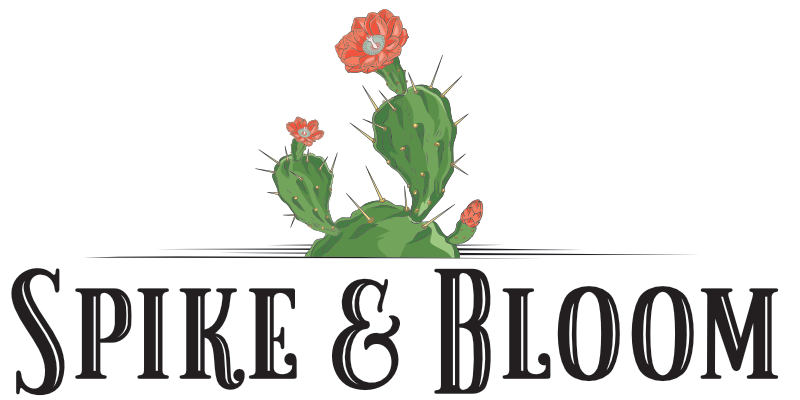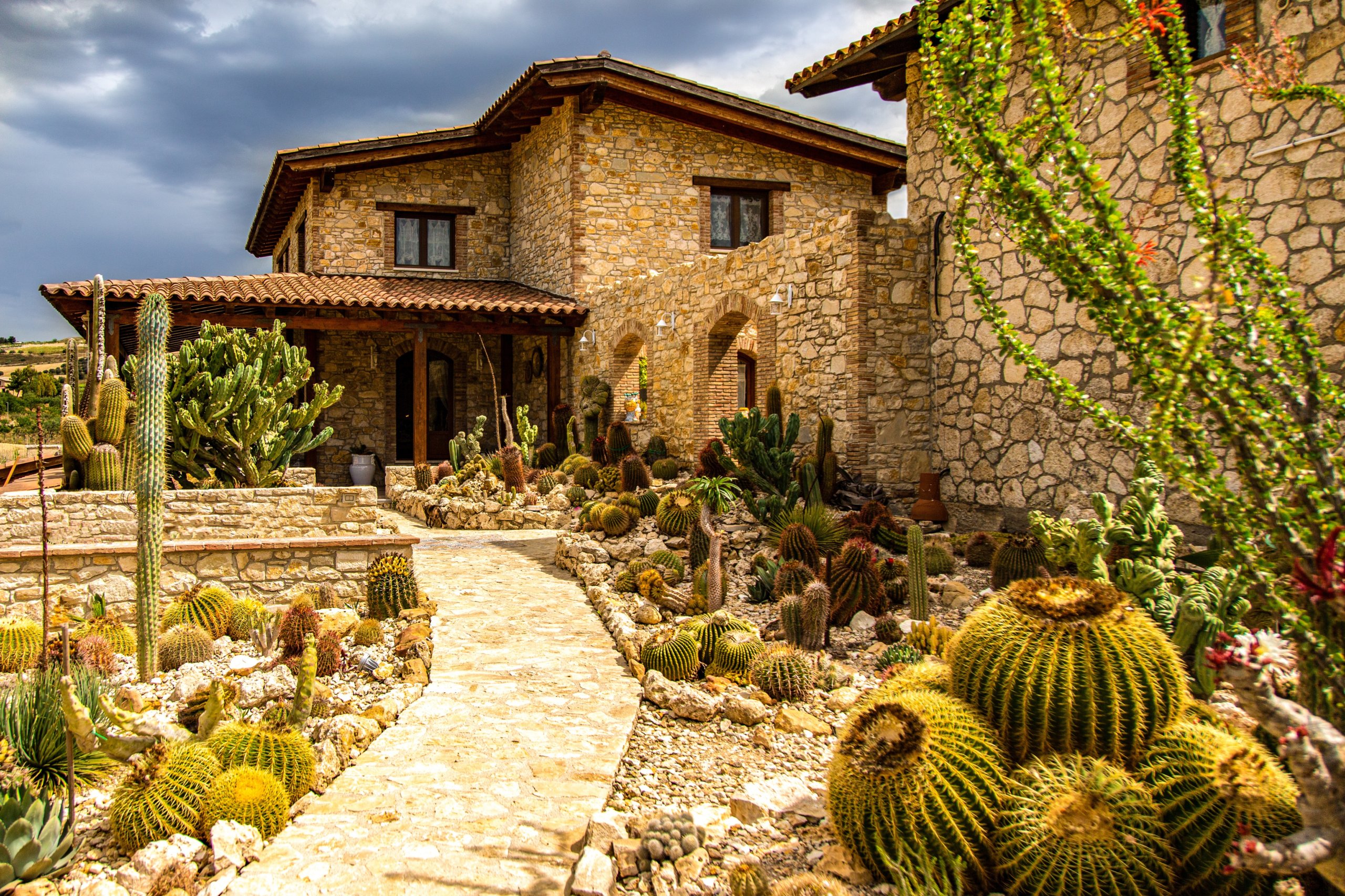Cactus Garden Design
Designing a cactus garden gives you a simple, low-maintenance way to create a striking outdoor or indoor space. These hardy plants thrive in dry conditions and bring structure, texture, and color to any setting. A well-planned cactus garden helps you achieve a beautiful, drought-tolerant landscape that requires little upkeep.
You can shape your design around natural desert themes or modern minimalist styles. Whether you have a large yard or a small balcony, cacti adapt easily to different spaces. With the right layout, soil mix, and plant choices, you can turn any sunny spot into a lasting display of form and contrast.
As you explore the fundamentals, creative ideas, and plant selection tips ahead, you’ll learn how to build a garden that looks professional yet stays easy to care for year-round.
Fundamentals of Cactus Garden Design
A successful cactus garden depends on light exposure, soil drainage, and plant compatibility. You create balance by matching cacti species to their environment and designing a layout that supports growth while maintaining visual harmony.
Choosing the Right Location
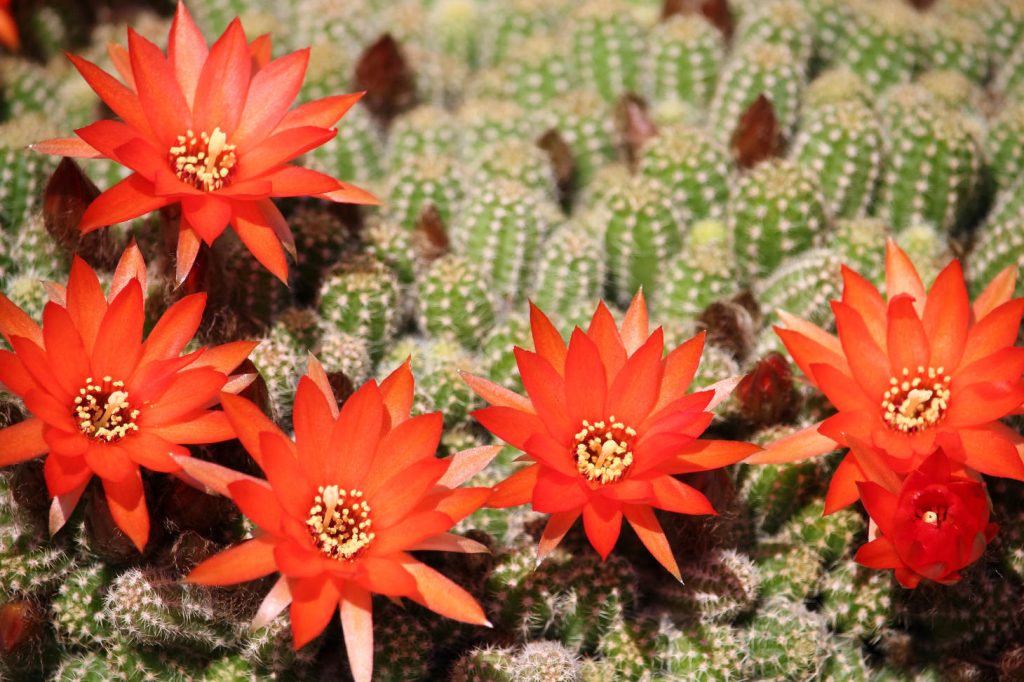
Most cacti require bright, direct light for at least 6–8 hours daily. South-facing areas often work best. Avoid shaded zones or spots near large trees that block light.
Good drainage is critical. Standing water leads to root rot. To improve poorly draining soil, either raise the planting bed or amend the soil heavily with materials like pumice or perlite. Even in containers, make sure each pot has drainage holes.
Wind exposure also matters. While cacti tolerate dry air, strong winds can damage tall or delicate species. A low wall or grouping of larger plants can serve as a natural windbreak.
For colder climates, consider portable containers or a greenhouse setup. This allows you to move your cacti indoors during frost or heavy rain.
Essential Design Principles
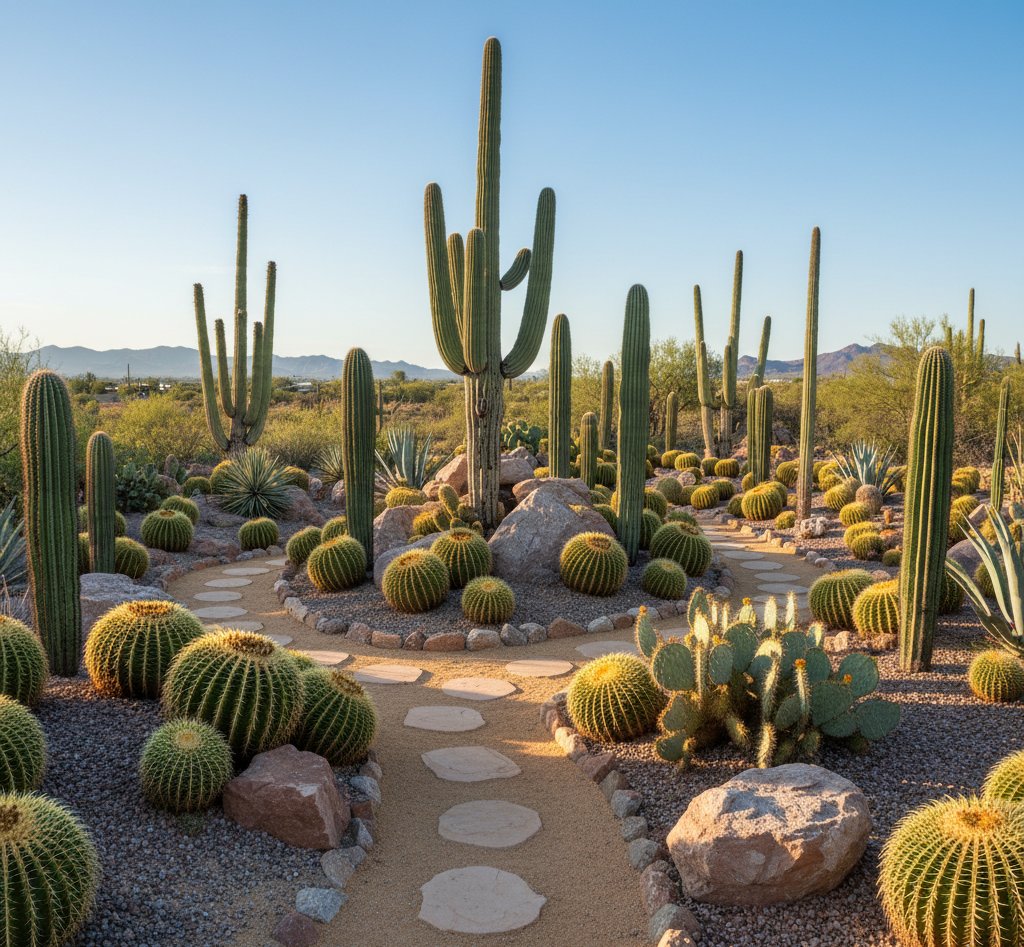
Cactus garden design works best when you plan for structure, spacing, and contrast. Arrange plants by height and shape to create depth. Taller columnar cacti make good focal points, while smaller or spherical varieties fill gaps below.
Use textures and colors to define sections. Pair smooth desert plants with spiny or ribbed cacti for variety. Incorporate rocks, gravel, or sand to mimic natural desert terrain and reduce weed growth.
Keep spacing consistent. Most cacti need airflow between plants to avoid fungal issues. A general guide is 12–24 inches apart, depending on size.
Add pathways or stepping stones for maintenance access. This prevents soil compaction and protects roots. A simple layout plan helps you visualize spacing before planting.
Selecting Compatible Cacti Varieties

Choose species that thrive in your local climate. For hot, dry regions, species like Echinocactus grusonii (Golden Barrel) or Opuntia (Prickly Pear) perform well. In cooler areas, use hardy types such as Escobaria or Cylindropuntia.
Mix rare and exotic cacti with common varieties to create visual interest. Use a table to help organize choices:
| Type | Growth Habit | Light Needs | Cold Tolerance |
|---|---|---|---|
| Golden Barrel | Round | Full sun | Low |
| Prickly Pear | Spreading | Full sun | Moderate-High |
| Saguaro | Columnar | Full sun | Low |
| Hedgehog Cactus | Clumping | Full sun | Moderate-High |
Group plants with similar watering and soil needs. Avoid mixing desert cacti with tropical succulents that require more moisture. This ensures consistent care and a healthier garden.
Creative Cactus Garden Ideas
You can design a cactus garden that fits both your space and your style. Use natural materials, thoughtful placement, and simple layouts to create a garden that looks appealing while staying easy to maintain.
Rock Garden Concepts

A rock garden gives cacti a natural setting that mimics their desert habitat. Use pumice, crushed lava rock, or perlite mixed into the soil for excellent drainage and root health. Arrange rocks in layers or clusters to create depth and highlight the shape of each cactus.
Choose low-growing species like Echinocereus or Rebutia for small gaps between rocks. Taller varieties, such as Trichocereus, can serve as focal points. Ensure adequate spacing to allow air flow and reduce moisture buildup.
Add a few succulents like agave or aloe for contrast. Their broader leaves balance the sharp forms of the cactus. A small table of materials can help guide your setup:
| Material | Purpose |
|---|---|
| Pumice/Perlite | Soil aeration and drainage |
| River/Volcanic stones | Natural border and mulch |
| Coarse Grit/Gravel | Top dressing to prevent soil splash |
| Boulders | Visual anchor |
Minimalist Cactus Garden Arrangements
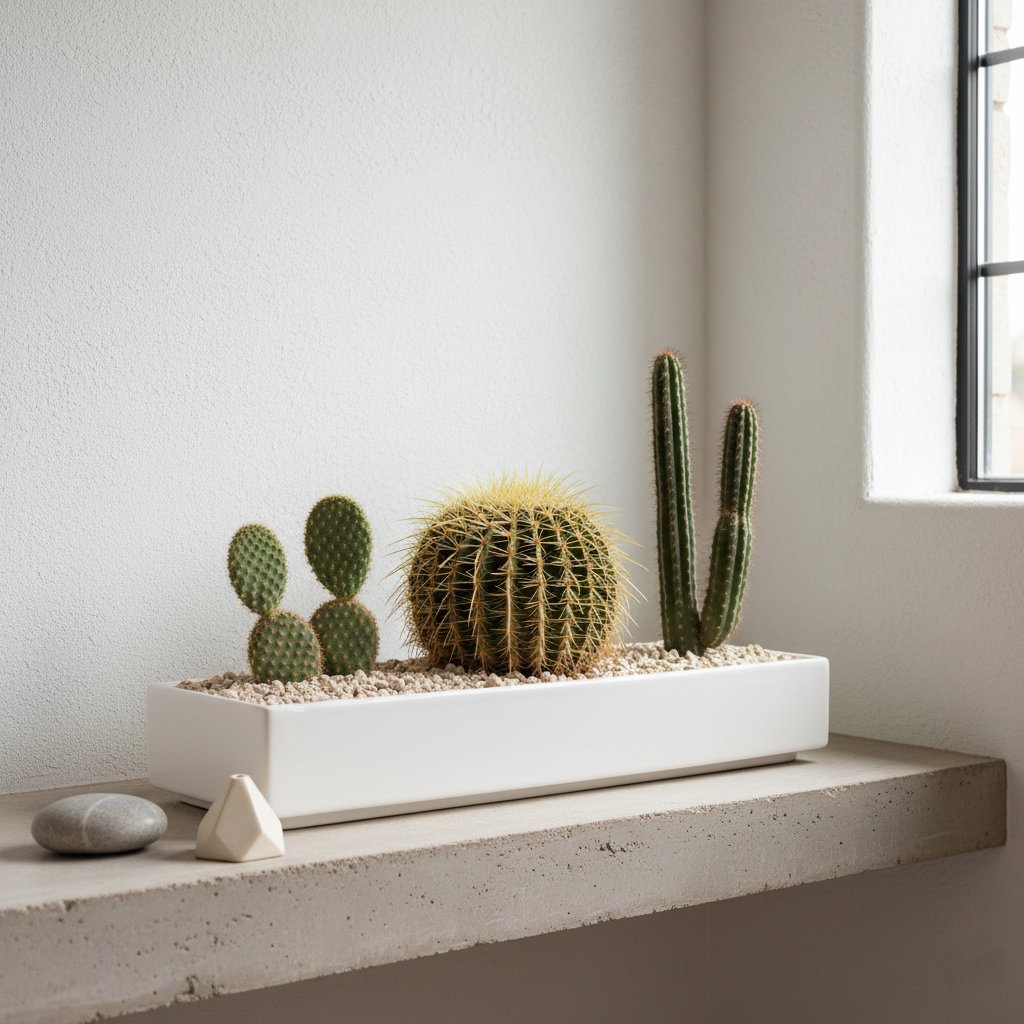
A minimalist cactus garden focuses on clean lines and open space. You can use a single large planter or a few small pots arranged in a row. Keep the color palette simple, neutral containers, light gravel, and a few well-chosen cactus species.
Select plants with distinct shapes, such as Golden Barrel or Bunny Ear cactus, to create visual interest without clutter. Limit decorative items to one or two pieces, like a small stone or ceramic accent.
Minimalist designs work well indoors or on patios. They require little upkeep beyond occasional watering and sunlight. This approach highlights form and texture rather than quantity, giving your garden a calm, balanced look.
Cactus Garden on a Hill
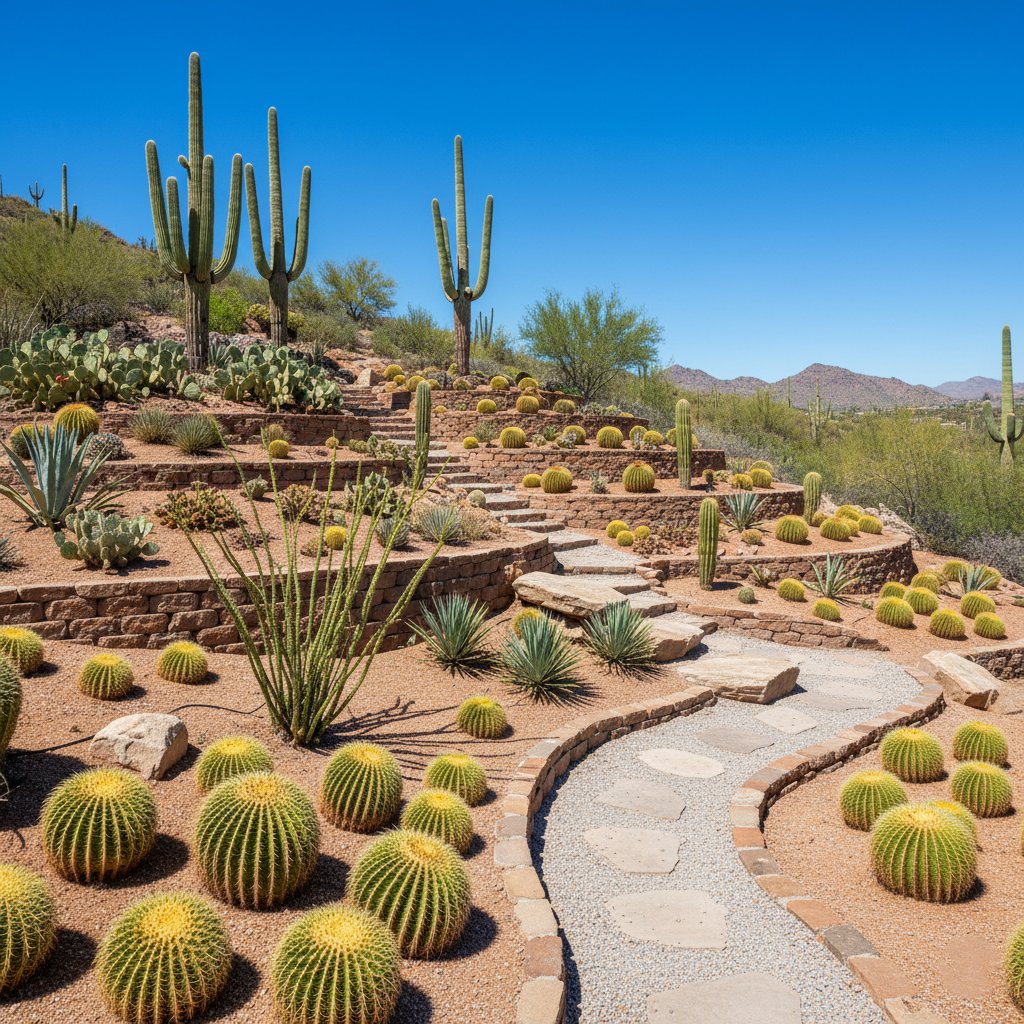
Building a cactus garden on a hill helps with natural drainage and adds visual height. Use terraces or small retaining walls to hold soil in place. Arrange larger cacti at the top and smaller ones near the base to create a layered effect.
Choose hardy species that tolerate full sun and sloped conditions, such as Prickly Pear or Saguaro. Mix in gravel pathways to make maintenance easier and reduce erosion.
Add a few flat stones where you can step or sit to view the garden from different angles. This design works well in dry climates and makes good use of uneven terrain.
Cactus Fence and Pathway Designs
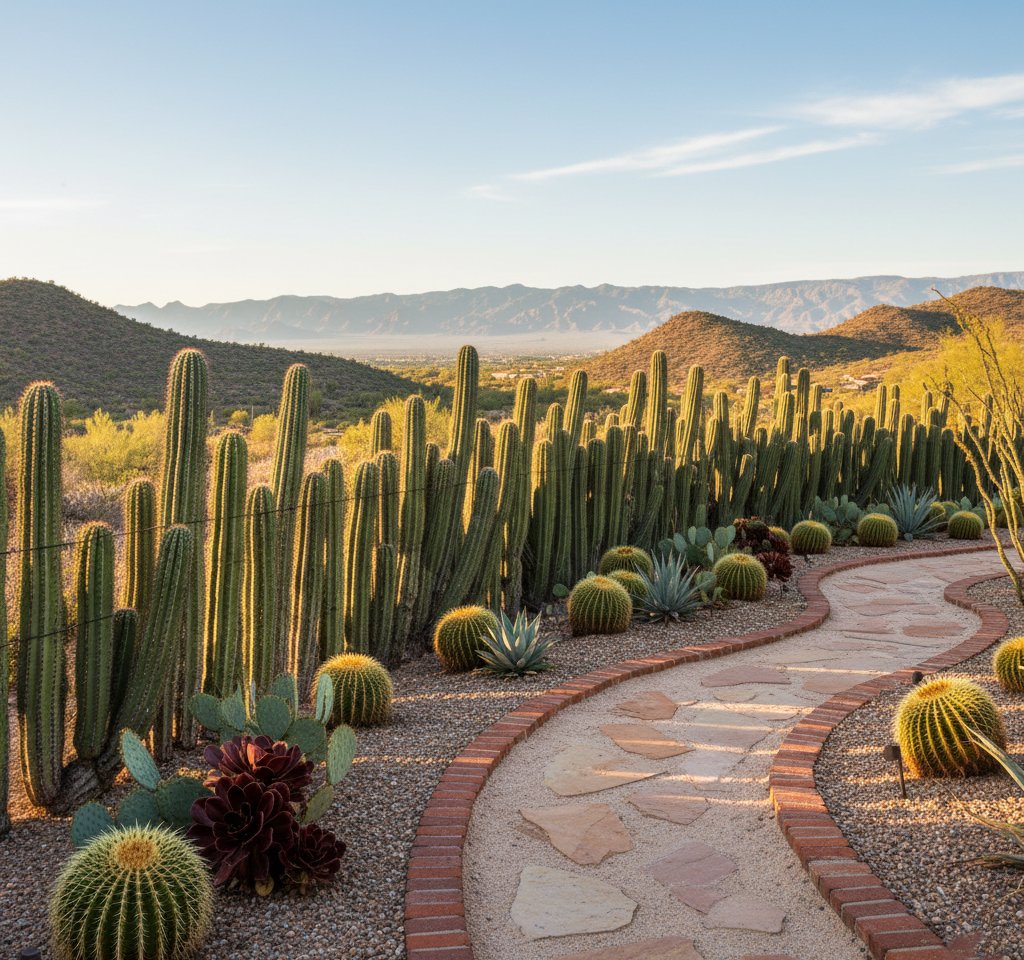
A cactus fence can define property lines or frame walkways while adding texture and security. Plant tall, columnar species like Organ Pipe or Mexican Fence Post cactus in a straight line. Keep spacing even to allow growth without overcrowding.
Combine the fence with gravel or stone pathways for a cohesive look. Use edging materials like brick or steel to keep the path neat. Smaller cacti or succulents along the border soften the transition between walkway and fence.
This design not only saves water but also creates a natural barrier that blends with desert landscapes. It works well for both residential yards and open garden spaces.
Indoor and Miniature Cactus Gardens
You can design small-scale cactus gardens that fit on tables, windowsills, or shelves. These gardens add greenery to limited spaces while staying easy to maintain. By choosing the right containers, arranging plants thoughtfully, and adding decorative materials, you can create displays that look balanced and stay healthy for years.
Indoor Cactus Garden Inspiration
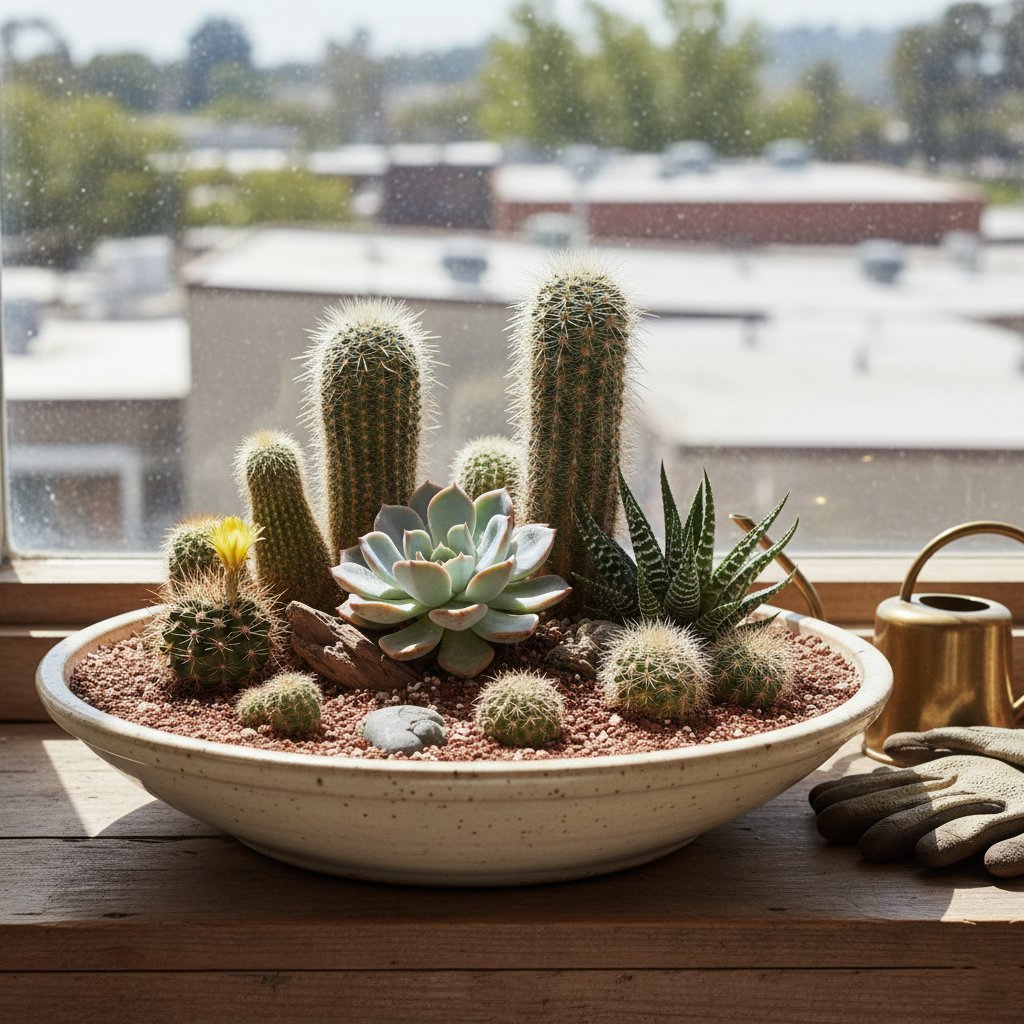
An indoor cactus garden works well in bright areas that receive several hours of direct sunlight daily. Use shallow containers with good drainage, such as ceramic bowls or wide terracotta pots. A mix of small cacti and succulents, like haworthia, echeveria, or mammillaria, creates contrast in shape and color.
Fill the container directly with fast-draining cactus soil. Position plants at different heights to build depth. You can group taller cacti toward the back and smaller ones near the front.
Keep your garden in the sunniest window available, often a south-facing one. Water lightly every few weeks, allowing the soil to dry completely between waterings.
Mini Cactus Garden Displays
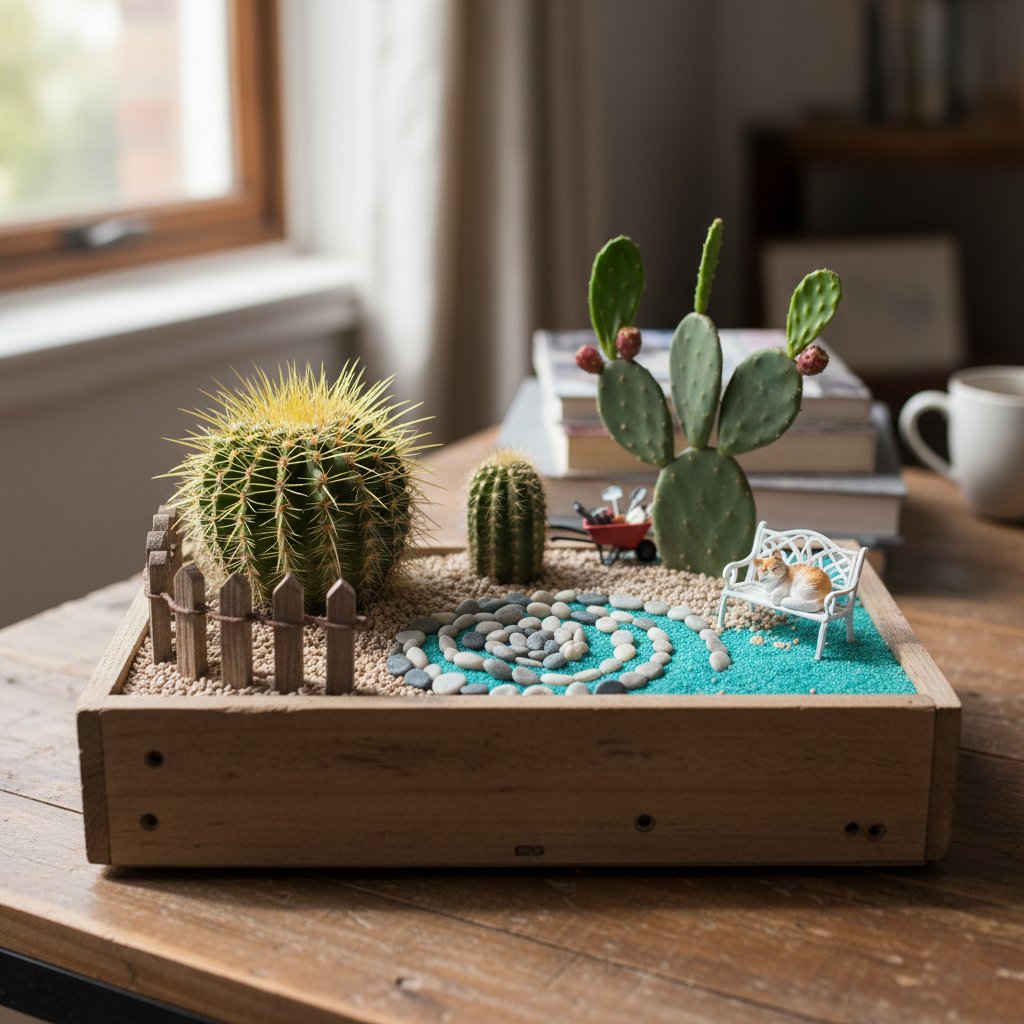
A mini cactus garden brings charm to small surfaces like desks or coffee tables. Use shallow dishes, teacups, or wooden boxes for a compact display. Combine two or three cactus varieties to create visual interest without overcrowding the space.
Add small pebbles or colored sand to define plant areas. You can include tiny figurines, fences, or miniature furniture for a playful touch. These details give your garden a finished look while keeping it simple to maintain.
For easy care, choose slow-growing species that stay small. Place the garden in bright light and rotate it occasionally for even growth. Ensure the container has drainage holes and water deeply, allowing the soil to dry completely between waterings.
Glass Balls and Decorative Elements
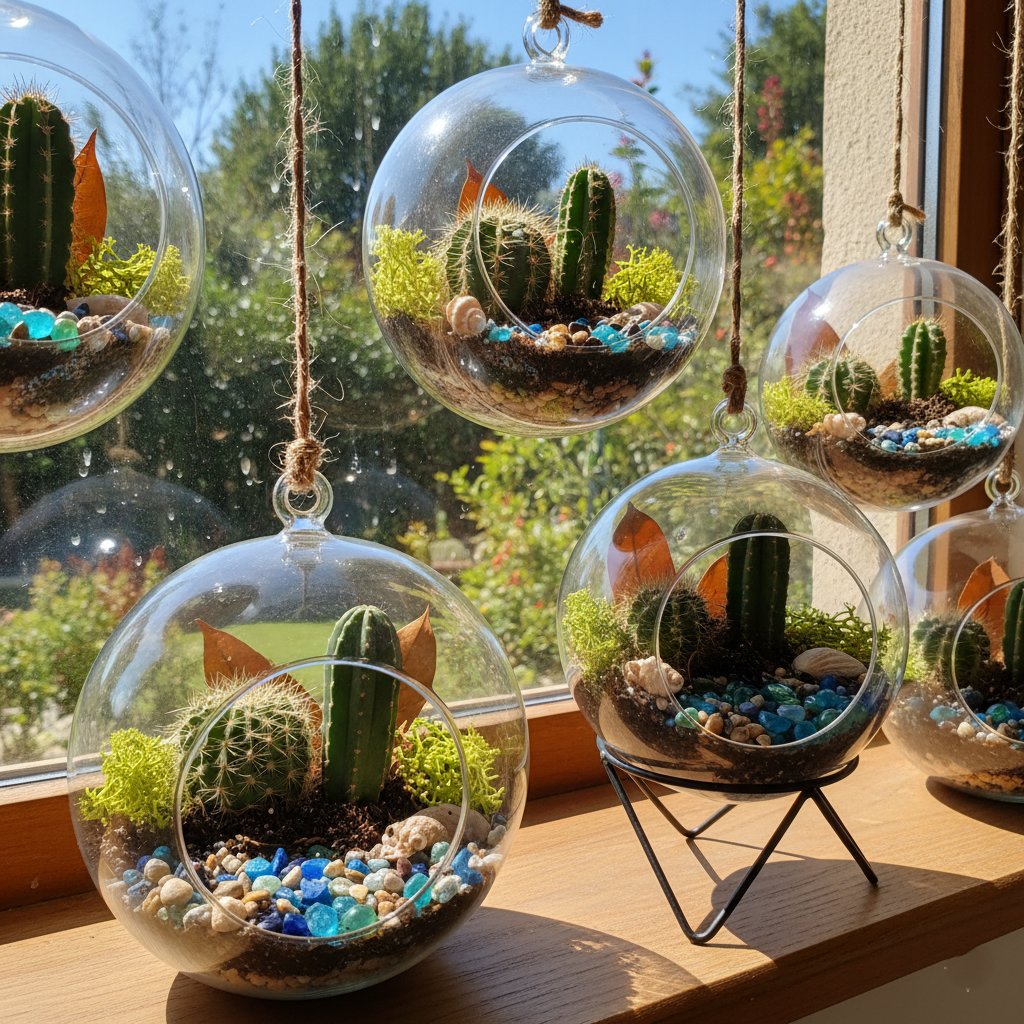
Hanging glass balls or terrariums make striking displays for small cacti. Their clear walls let you see each layer of soil, sand, and stone, adding structure and color to your arrangement. Choose open-top designs to allow airflow and prevent excess moisture.
Fill the bottom with a thin layer of gravel, then add cactus soil and one or two miniature plants. Use tweezers or long tools to position them carefully inside the sphere.
You can hang glass balls near windows or set them on stands. Add decorative elements like colored pebbles, preserved moss, or shells for texture. Place the display where the plant receives the brightest, most direct sunlight possible.
Plant Selection
Choose plants that handle dry conditions, need little water, and grow well in full sun. Focus on matching species to your local climate and soil type to keep maintenance low and growth healthy.
Combining Cacti and Succulents

Mixing cacti with succulents adds variety in shape, color, and texture. You can pair tall columnar cacti with low-growing succulents like aloe or echeveria for contrast. Group plants with similar light and water needs to avoid overwatering or root rot.
Use a cactus soil mix that drains quickly. You can make your own by blending coarse sand, perlite, and potting soil. This keeps roots dry and prevents fungal problems.
When planting, leave space between each plant for airflow and growth. Top-dressing with gravel is a great aesthetic addition that keeps the plant’s base dry.
Raised Beds and Containers
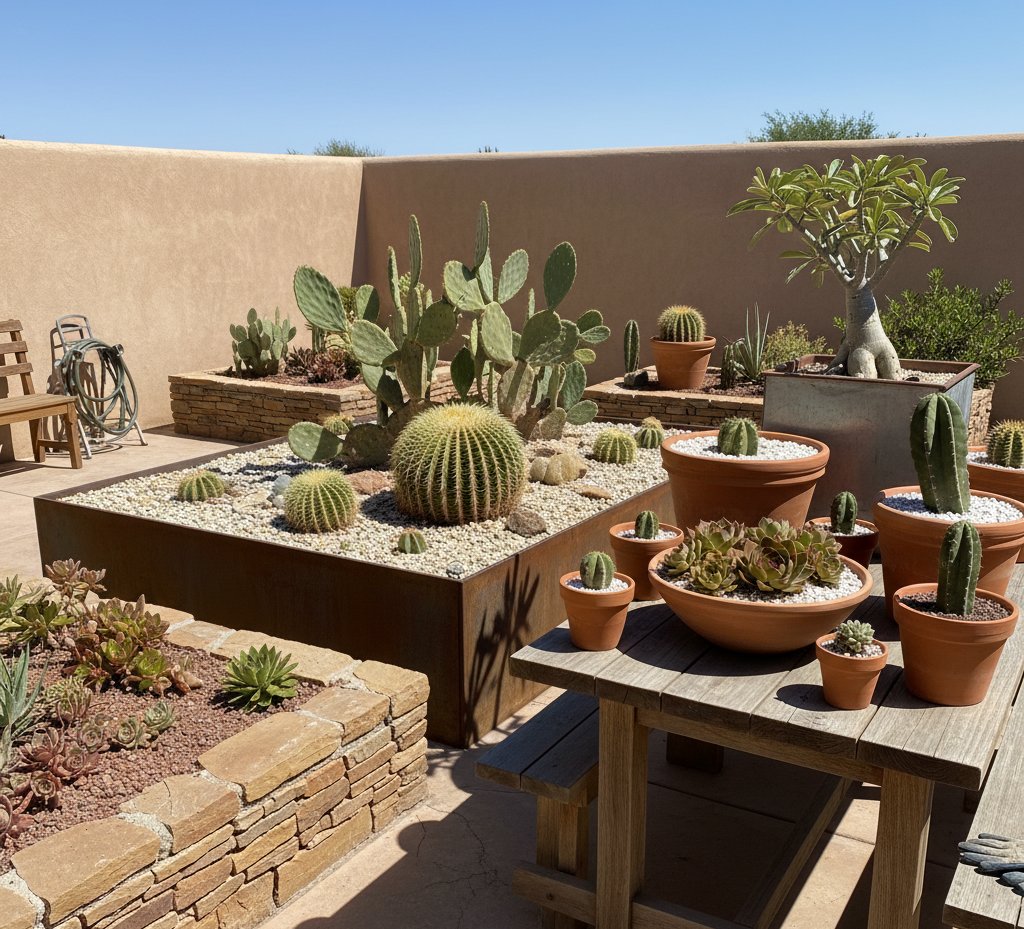
Raised beds and containers help control soil quality and drainage. They also make it easier to adjust placement for sunlight and protect plants from heavy rain. Choose materials like stone, metal, or weather-resistant wood that resist heat and weathering.
Fill beds or pots with a fast-draining cactus soil mix. Avoid regular garden soil, which holds too much water. You can top the surface with gravel or crushed stone to reflect heat and keep weeds down.
In containers, pick sizes that allow root growth. Shallow, wide pots work best for succulents, while deeper pots suit larger cacti. Place containers where they get at least six hours of sunlight each day for strong, even growth.
